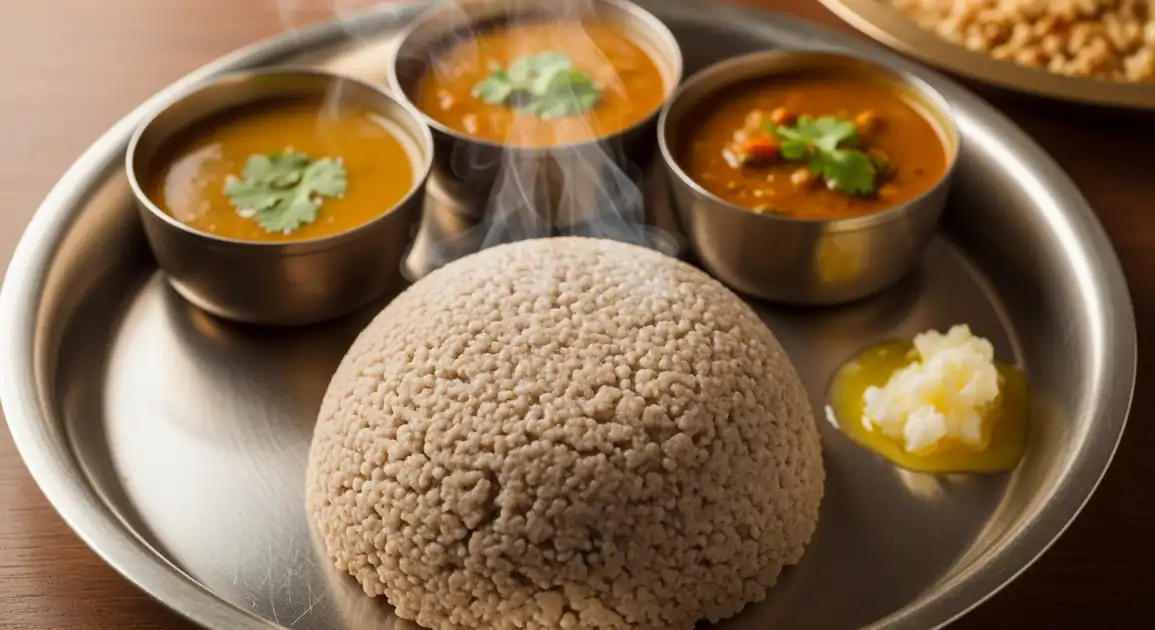Dhindo (Nepali Porridge/Dough)
ढिँडो

Description
In Kathmandu, Dhindo is readily available in numerous restaurants catering to both locals and tourists seeking authentic Nepali cuisine. Establishments specializing in Thakali food are particularly famous for their well-prepared Dhindo sets. You can find options ranging from simple local eateries to more upscale restaurants offering this traditional staple.
Dietary Information
Serving information
Serving style
Typically served as a 'Dhindo Thali Set' on a large metal plate with various accompanying bowls of side dishes.
Quick facts
11:30 AM - 3 PM for lunch, 6 PM - 10 PM for dinner.
Safety Tips
What to Look For
-
Served steaming hot
Ensures the Dhindo is freshly cooked and pathogens killed during boiling. Dhindo cools quickly and texture changes.
-
Smooth, homogenous consistency
Well-made Dhindo should be free of lumps ('dalla'). Lumps indicate improper cooking.
-
Fresh-looking and properly stored side dishes
Dal, tarkari, achar should appear fresh. Ensure curries are hot and pickles/salads handled hygienically.
-
Clean restaurant environment
General cleanliness of the eating area and kitchen (if visible) is a good indicator of overall hygiene standards.
-
Made with boiled water
The water used for cooking must be thoroughly boiled to ensure safety, which is inherent in the Dhindo preparation process itself.
What to avoid
-
Lukewarm or cold Dhindo
Unpleasant texture and potential safety risk if left sitting out.
-
Lumpy or watery Dhindo
Indicates poor preparation, although not necessarily unsafe if hot.
-
Side dishes (especially meat/dairy) left at room temperature for long periods
Increases risk of spoilage and foodborne illness.
-
Visibly unclean serving utensils or plates
Potential source of contamination.
Price information
Price range
Budget tips
- Thakali restaurants in areas slightly outside the main Thamel tourist hub might offer better value.
- Look for smaller eateries advertising 'Nepali Khana Set'.
- Prices are generally higher than in rural areas but still reasonable for a full meal.
Value indicators
- Restaurant reputation for Thakali or Nepali food.
- Freshness and heat of the Dhindo upon serving.
- Quality and variety of side dishes (especially good gundruk or dal).
- Cleanliness of the establishment.
Where to Find This Dish
Thamel
Many restaurants catering to tourists offer Dhindo sets, quality can vary. Look for those specializing in Nepali/Thakali food.
Tourist streets, Side alleys
Lunch, Dinner
Lazimpat / Maharajgunj
Areas with numerous popular Thakali restaurants frequented by locals and expats.
Near embassies, Main roads
Lunch, Dinner
Jawalakhel / Patan (Lalitpur)
Good options for authentic Thakali and Newari cuisine (though Dhindo isn't Newari, it's often served in Nepali restaurants here).
Jawalakhel Chowk, Patan Durbar Square vicinity
Lunch, Dinner
Local Neighborhood Eateries
Smaller 'khaja ghars' in various neighborhoods might offer simpler Dhindo sets.
Residential areas
Lunch, Dinner
Vendor Tips
- Ask fellow diners or hotel staff for recommendations on good Thakali places.
- Buckwheat ('fapar') and millet ('kodo') are common flour options offered in Kathmandu.
- Specify if you want a vegetarian ('shakahari') or non-vegetarian ('mansahari') set.
How to Order
Regional Variations
-
Restaurant Style Sets
(Restaurant ko Set)
Sets in Kathmandu restaurants might offer a wider variety of side dishes or slightly more refined presentation compared to very rural settings.
-
Flour Availability
(Pitho ko Uplabdhata)
Easier to find specific flour types (buckwheat, millet, corn) requested in Kathmandu restaurants compared to some remote areas.
Cultural context
History
Dhindo has been a cornerstone of Nepali cuisine for centuries, especially among ethnic groups like the Gurung, Magar, Rai, Limbu, and Tamang inhabiting the hills and mountains where rice cultivation was difficult or insufficient. Its ingredients – hardy grains like buckwheat and millet – grow well at higher altitudes. Dhindo provided essential energy and sustenance for agrarian communities involved in strenuous physical labor. It represents resilience, simplicity, and connection to the land.
Local significance
While Kathmandu is diverse, Dhindo represents a connection to the country's rural and mountainous heritage. It's enjoyed by Nepalis from various backgrounds and increasingly by tourists seeking authentic experiences.
Eating customs
- Using hands is common but cutlery is always available.
- Taking refills ('thap') of dal and tarkari is encouraged.